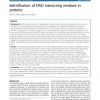145 search results - page 8 / 29 » Predicting DNA-binding sites of proteins from amino acid seq... |
BMCBI
2010
13 years 7 months ago
2010
Background: Small molecular cofactors or ligands play a crucial role in the proper functioning of cells. Accurate annotation of their target proteins and binding sites is required...
BMCBI
2010
13 years 7 months ago
2010
Background: Knowledge-based potentials have been widely used in the last 20 years for fold recognition, protein structure prediction from amino acid sequence, ligand binding, prot...
BMCBI
2010
13 years 7 months ago
2010
Background: Flavin binding proteins (FBP) plays a critical role in several biological functions such as electron transport system (ETS). These flavoproteins contain very tightly b...
BMCBI
2006
13 years 7 months ago
2006
Background: Many dimeric protein complexes bind cooperatively to families of bipartite nucleic acid sequence elements, which consist of pairs of conserved half-site sequences sepa...
ICASSP
2007
IEEE
14 years 1 months ago
2007
IEEE
Protein structure prediction aims to determine the three-dimensional structure of proteins form their amino acid sequences. When a protein does not have similarity (homology) to a...


